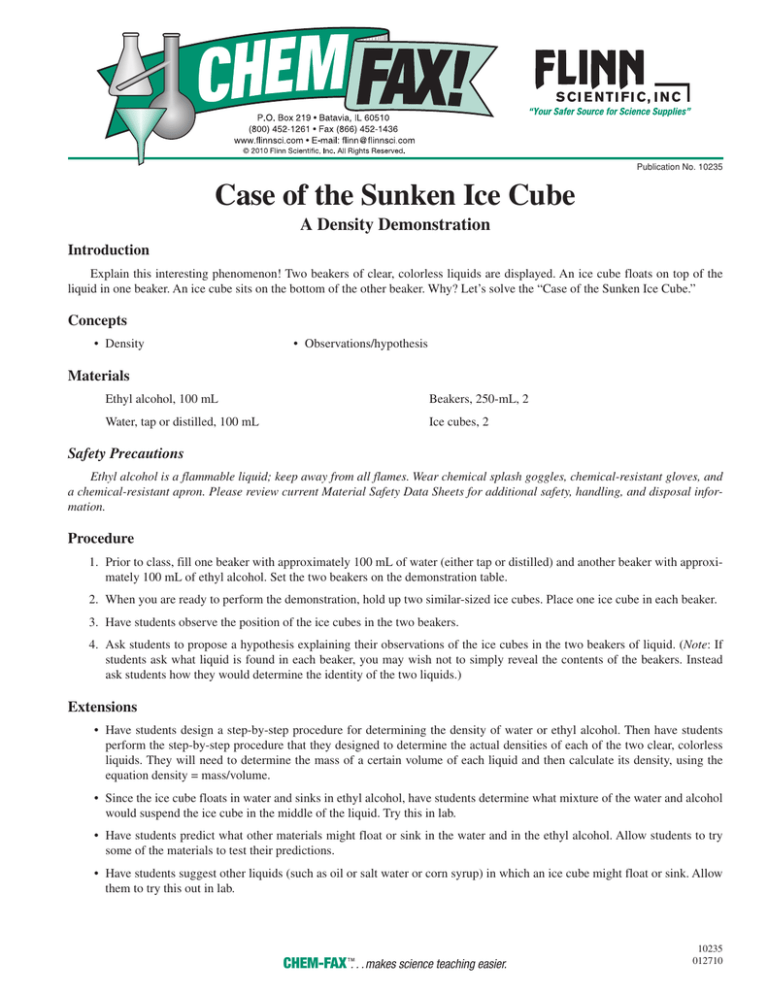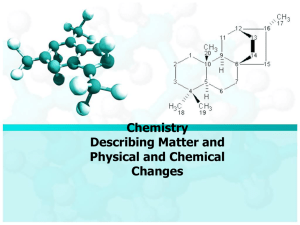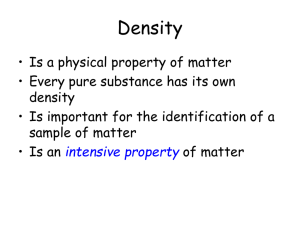
Publication No. 10235
Case of the Sunken Ice Cube
A Density Demonstration
Introduction
Explain this interesting phenomenon! Two beakers of clear, colorless liquids are displayed. An ice cube floats on top of the
liquid in one beaker. An ice cube sits on the bottom of the other beaker. Why? Let’s solve the “Case of the Sunken Ice Cube.”
Concepts
• Density
• Observations/hypothesis
Materials
Ethyl alcohol, 100 mL
Beakers, 250-mL, 2
Water, tap or distilled, 100 mL
Ice cubes, 2
Safety Precautions
Ethyl alcohol is a flammable liquid; keep away from all flames. Wear chemical splash goggles, chemical-resistant gloves, and
a chemical-resistant apron. Please review current Material Safety Data Sheets for additional safety, handling, and disposal information.
Procedure
1. Prior to class, fill one beaker with approximately 100 mL of water (either tap or distilled) and another beaker with approximately 100 mL of ethyl alcohol. Set the two beakers on the demonstration table.
2. When you are ready to perform the demonstration, hold up two similar-sized ice cubes. Place one ice cube in each beaker.
3. Have students observe the position of the ice cubes in the two beakers.
4. Ask students to propose a hypothesis explaining their observations of the ice cubes in the two beakers of liquid. (Note: If
students ask what liquid is found in each beaker, you may wish not to simply reveal the contents of the beakers. Instead
ask students how they would determine the identity of the two liquids.)
Extensions
• Have students design a step-by-step procedure for determining the density of water or ethyl alcohol. Then have students
perform the step-by-step procedure that they designed to determine the actual densities of each of the two clear, colorless
liquids. They will need to determine the mass of a certain volume of each liquid and then calculate its density, using the
equation density = mass/volume.
• Since the ice cube floats in water and sinks in ethyl alcohol, have students determine what mixture of the water and alcohol
would suspend the ice cube in the middle of the liquid. Try this in lab.
• Have students predict what other materials might float or sink in the water and in the ethyl alcohol. Allow students to try
some of the materials to test their predictions.
• Have students suggest other liquids (such as oil or salt water or corn syrup) in which an ice cube might float or sink. Allow
them to try this out in lab.
CHEM-FAX姠. . .makes science teaching easier.
10235
012710
• Allow students to hypothesize why ice floats on water when, in fact, most substances become more dense (molecules
move slower and closer together) as they solidify and thus would sink.
• Have students compare the densities of fresh water (d = 1.00 g/cm3) and seawater (d = 1.03 g/cm3) at 25 °C. How does this
affect buoyancy? Is it easier to float in a freshwater lake or in the ocean? Explain.
Disposal
Please consult your current Flinn Scientific Catalog/Reference Manual for general guidelines and specific procedures, and
review all federal, state and local regulations that may apply, before proceeding. The solutions may be flushed down the drain with
excess water according to Flinn Suggested Disposal Method #26b.
Discussion
Density is the quantity of matter in a given unit of volume, stated as density = mass/volume, generally given in SI units of
g/cm3. Density is an internal physical property and thus is often used to identify a substance. Water has density of 1.00 g/cm3 at 25
°C, meaning that a mass of 1.00 gram of water occupies a space of 1.00 cubic centimeter. Materials that are less dense than water
(or have a density lower than 1.00 g/cm3) will float in water, while materials that are more dense than water (or have a density
greater than 1.00 g/cm3) will sink. The same is true of any liquid, such as ethyl alcohol with a density of 0.79 g/cm3. Materials
less dense than ethyl alcohol will float in it, while materials more dense will sink. Therefore as observed in this demonstration, ice
with a density of 0.92 g/cm3 will float in water but will sink in ethyl alcohol.
When water solidifies to form ice, the solid ice phase is less dense (as observed) than the liquid water. This can be attributed
to the hydrogen bonding that occurs in water in both the liquid and solid states. Hydrogen bonding is the strong intermolecular
dipole–dipole force between the partially-positive hydrogen atom and the partially-negative oxygen atom of neighboring water
molecules. When water freezes, hydrogen bonding holds molecules rigidly in a three-dimensional crystal. There are holes, or
empty spaces, within the ice crystal. As water freezes to form ice, it must expand (rather than contract) to form this open crystal.
As a result, the density of ice is less than the density of liquid water, which explains why ice floats in water. This is a very unusual
phenomenon. Most substances are more dense in the solid state than in the liquid state because particles are usually closer together
in the solid state. Water is the rare and unique exception.
Connecting to the National Standards
This laboratory activity relates to the following National Science Education Standards (1996):
Unifying Concepts and Processes: Grades K–12
Evidence, models, and explanation
Constancy, change, and measurement
Content Standards: Grades 5–8
Content Standard A: Science as Inquiry
Content Standard B: Physical Science, properties and changes of properties in matter
Content Standards: Grades 9–12
Content Standard A: Science as Inquiry
Content Standard B: Physical Science, structure and properties of matter, chemical reactions
Reference
Summerlin, L. R.; Borgford, C. L.; Ealy, J. B. Chemical Demonstrations: A Sourcebook for Teachers, Vol. 2; American Chemical
Society: Washington, DC. 1988; pp 15–16.
Materials for the Case of the Sunken Ice Cube are available from Flinn Scientific, Inc.
Catalog No.
E0009
Description
Ethyl alcohol, 500 mL
Consult your Flinn Scientific Catalog/Reference Manual for current prices.
–2–
© 2010 Flinn Scientific, Inc. All Rights Reserved.
10235


